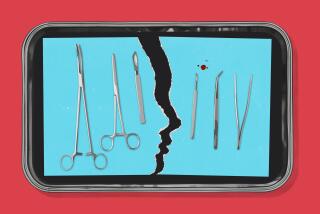Good Health Magazine : MEDICINE : IN BY 7, OUT BY 5 : IN OUTPATIENT CENTERS AROUND THE COUNTRY, DOCTORS ARE PERFORMING SURGICAL PROCEDURES THAT ONCE REQUIRED WEEKS OF RECOVERY AND ARE SENDING PATIENTS HOME THE SAME DAY.
- Share via
In Nashville, a man has surgery to remove his gall bladder in the morning, goes home the same afternoon and is back at work within a few days. In Sacramento, a woman has surgery Thursday morning to stop excessive bleeding in her uterus, goes home after a few hours, is back on the job on Monday and is doing aerobics within a week.
In outpatient surgery centers around the country, surgeons are removing ovaries, gall bladders, appendixes and tonsils, repairing hernias, doing penile implants--surgical procedures that used to require weeks of recovery--and sending their patients home the same day.
Last year, 48.8% of the 24 million operations performed in the United States were done on an outpatient basis, and the trend is growing. Outpatient surgery is less costly and more convenient than hospitalization, so its popularity with patients, and insurance companies, is not surprising. But its significance has resulted from a change in technique: specifically, the elimination--whenever possible--of large, and painful, incisions.
“What you do to get there is what causes the pain, not what you do inside,” says Eddie Joe Reddick, a Nashville surgeon. Reddick is a pioneer in laparoscopic cholecystectomy, a new procedure for gall bladder removal. Traditionally a surgeon would make a long incision, slicing through the abdominal muscle. Reddick’s procedure uses surgical video-technology that leaves a patient’s insides untouched by human hands. Lasers, cutting tools and video cameras (endoscopes and laparoscopes) are inserted through tiny incisions that do not cut the abdominal muscle. The surgeon literally operates under the skin, using a television monitor as a guide. This decreases the risk of infection and leaves only slight scarring. Most important, recovery time drops from six days in a hospital and four to six weeks at home to--in many cases--four or five days at home.
With many outpatient surgeries, patients don’t have to spend even one minute in a hospital: One in five such procedures is performed at free-standing surgical centers. The first surgical center opened in Phoenix in 1970, but it wasn’t until the 1980s that the idea caught on; the count skyrocketed from 283 seven years ago to 1,227 in 1989.
Most such centers were founded by physicians frustrated with crowded hospital operating rooms. Scheduled hospital surgeries often are shuffled because priority is given to emergency operations. And as Medicare payments began drying up, doctors looked for ways to increase their income. “What we’re seeing goes back to the 1930s and 1940s, when physicians established hospitals as a way to generate more income,” says John Henderson, president of Chicago’s SMG Marketing Group, which works with many surgery centers.
Hospitals, keenly aware of lost revenue, have entered the outpatient-surgery field by buying or building their own surgical centers, or designated operating rooms within the hospital for outpatient use only.
Gynecology is one of the fastest-growing segments of outpatient surgery; it accounted for 19.6% of such operations last year. Late one sunny morning, Suzanne Swendiman, 48, a junior high school vice principal, smiled and waved to her gynecologist, Gary Fields, as she was wheeled into one of the four operating rooms of the Sutter Surgery Center, a small building surrounded by trees in a Sacramento office park. She was about to have an operative hysteroscopy to remove a bleeding fibroid.
Tumors, fibroids and polyps can now be detected during a diagnostic hysteroscopy, which is often performed when a woman experiences unusual bleeding. In this procedure, the doctor inserts a hysteroscope--a long, thin tube with a camera at the end--into the uterus and watches a video monitor; it is done in the doctor’s office with local anesthesia. In the past, a dilation and curettage, in which the cervix is dilated and the uterus scraped for a tissue sample, would have been Swendiman’s first option to control her bleeding.
“It’s amazing how much we missed (with D and Cs),” says Arthur McCausland, a Sacramento gynecologist who stopped doing the procedure two years ago. “Most of the time, we’d pick up a cancer, but we might miss polyps and fibroids. It was like practicing in the Dark Ages.”
“D and Cs ought to be relegated to history,” says Franklin Loffer, a Phoenix gynecologist, who pioneered many outpatient gynecological procedures.
An operative hysteroscopy uses instruments that have tools attached--cutting or cauterizing devices, or lasers to cut off polyps or fibroids that cause the bleeding. After Swendiman had drifted into unconsciousness under general anesthesia, Fields inserted a resecto-scope. The television monitor showed a pink fibroid--a benign tumor common in premenopausal women--with a surface gorged with red vessels oozing blood into the uterus. Watching the monitor, Fields squeezed a trigger on the resecto-scope, releasing a tiny half-loop that appeared from beneath the camera’s lens. He maneuvered the loop and applied an electric current to cut away part of the tumor that was the source of most of the bleeding. As he cut, bits and pieces of tumor disappeared from the TV screen, flushed away by a liquid that was continually pumped into the uterus. Forty-five minutes after entering the operating room, Swendiman was taken to a recovery room. In another 30 minutes, she dressed and went home.
“I had no problems with it at all,” Swendiman said later. “I appreciated the quickness. I wanted to go home. I was up and about the next day.”
In the past, if the D and C hadn’t worked, Swendiman probably would have had a hysterectomy. With hysteroscopic technology now available, doctors estimate that 20% to 30% of this country’s annual 500,000 hysterectomies, each of which requires four or five days of hospitalization and four to six weeks recovery at home, will become unnecessary.
“Often, physicians take out a uterus before a woman gets a chance to bear children,” says Ana Murphy, a reproductive endocrinologist at the UC San Diego School of Medicine. “The problem may be as simple as a few polyps, and a lot of them can be removed through hysteroscopy and not hysterectomies.”
Many outpatient procedures are more borrowed than new. Gynecologists and ear, nose and throat surgeons--who have been doing sinus endoscopies for about three years--adapted the endoscope from urologists. General surgeons, in turn, borrowed the laparoscope--essentially, an endoscope that is inserted surgically into the abdomen--from gynecologists.
Outpatient surgery is also being fueled by new developments in anesthesia. With some knee and shoulder operations, for example, post-operative pain is so intense for a day or two that patients must remain in the hospital simply so nurses can administer medication that can be given only intravenously or by injection, and can monitor such side effects as respiratory problems.
But with new drugs such as propofol, patients recover in 30 to 40 minutes instead of in five to 12 hours. And some patients can administer the drugs themselves at home, using a Walkman-size pump attached intravenously (although most must employ a nurse for a couple of days). Anesthesia is automatically delivered through the i.v. line in predetermined time increments. Patients have the option of self-injecting extra pre-measured medication between scheduled dosages, but cannot give themselves an overdose.
“This isn’t suitable for everybody,” says Houston anesthesiologist Carl Battaglia, president of the Federated Ambulatory Surgery Assn. and medical director of the Texas Outpatient Surgicare Center. “The person has to be responsible and have a responsible person at home the first 24 hours.”
Outpatient surgery isn’t for everyone, either. People who are over 60 years old, who have an acute infection of the diseased organ to be removed or other medical problems will have their surgery in a hospital, Reddick says. “And there’s always a subset (of people) who simply don’t want to be treated as outpatients,” he adds.
There is also the problem of availability. Although outpatient surgery is popular, it is most common in cities where surgeons develop and perfect specific procedures. Reddick is so experienced at laparoscopic cholecystectomies that he’s turned it into an outpatient procedure; 50% to 60% of his patients go home the day of surgery. Although surgeons in San Francisco and Los Angeles are doing the operation, they don’t have Reddick’s experience and thus choose to perform the surgery in a hospital.
Another problem is proper training. Many of the new gynecological procedures and the training for them emanate from Phoenix, where Loffer was one of the first to use the resectoscope, the half-loop cutting tool that Fields used on Swendiman; the YAG laser, used to stop bleeding by cauterizing endometrial tissue, and the “roller ball”--a small device that looks like a BB shot held between two wires--that also cauterizes endometrial tissue by delivering an electrical current as a surgeon rolls it across the uterine wall. Loffer has taught more than 500 doctors how to do laparoscopies.
However, because outpatient surgery is so different, “it’s not painless to learn how to do,” says UC San Diego’s Murphy. “The way we are trained to look at tissue is to feel it. You can’t do that in laparoscopic surgery. You have to be retrained to view on a television screen and use non-traditional instruments.”
Although residents in teaching hospitals, such as UC San Diego School of Medicine, now receive training in the new techniques, physicians in private practice who wish to use these techniques must retrain with already-expert surgeons such as Loffer, Reddick and Murphy, from whom they will usually get a certificate. Optimally, physicians-in-training start on inanimate objects. Then they watch experienced doctors at work and finally perform the techniques on patients under supervision. But not all doctors receive adequate training.
“Some of the courses (being taught at schools) are totally inadequate,” says Duane Townsend, professor and vice chairman of the department of obstetrics and gynecology at the UC Davis School of Medicine. “What concerns me is that physicians who attend a course and don’t get hands-on training might go back and hurt somebody.”
Townsend has trained 60 physicians in hysteroscopy and has refused to certify three. He advises anyone considering outpatient surgery to determine whether the surgeon involved has taken a course that requires hands-on training and has done five or six cases under direct supervision (certification is not legally required). Townsend also suggests talking to others who have had the particular surgery. “Ask to talk to a woman who’s had the surgery,” he recommends. “Find out the results.”
Patients also should check whether the anesthesiologists are using new drugs, such as propofol (marketed as Diprivan), that allow for shorter recovery periods. Some anesthesiologists administer the same drugs used in traditional operating rooms, with the result that some of their patients suffer from more severe side effects and require a longer recovery period.
Now that outpatient surgery has gained such momentum, its uses seem limitless.
“We initially never thought we could do a hernia operation on an outpatient basis, but we can,” Reddick says. “We never thought we could do a hemorrhoidectomy on an outpatient basis, but we can. We never thought we could do appendectomies, but we can. I think in the future we’ll be doing surgery without ever making a cut. I think there are ways to do that.”
More to Read
Sign up for Essential California
The most important California stories and recommendations in your inbox every morning.
You may occasionally receive promotional content from the Los Angeles Times.













